Top 10 Computer Viruses
Top 10
Computer Viruses
10. Melissa
Combine the illicit thrill of an exotic dancer
with the manipulative genius of a hacker and you have one of the worst computer
viruses of all time. Melissa was created by David L. Smith, named for his
favorite Friday Night Gal, and released into the world on March 26th,
1999. Posing as an email attachment, the self-replicating virus
activated when the malicious attachment was opened, then sent itself to the top
50 people in the email client contact list. The damage was so great that some
companies had to shut down email programs until the virus was contained. Smith
was convicted, fined $5,000 and spent 20 months in jail. Before Melissa, public
knowledge of the detriment of malware was previously unknown.
9. ILOVEYOU/Love Letter
 Ironically named, this love letter was sent
from the Philippines in May of 2000 and wreaked havoc on computers around the
world. Beginning as an email that claimed the attachment contained honey-filled
words from a secret admirer, the subsequent worm that was unleashed worked in
multiple ways. After copying itself into several different files and adding new
registry
keys to the victim’s computer, ILOVEYOU would then download a password stealing
application that would email personal data to the hacker’s account. ILOVEYOU
then used email and chat clients to send itself to other sources, further
perpetuating the cycle. Some sources claim the ILOVEYOU computer virus caused
over $10 billion in damages.
Ironically named, this love letter was sent
from the Philippines in May of 2000 and wreaked havoc on computers around the
world. Beginning as an email that claimed the attachment contained honey-filled
words from a secret admirer, the subsequent worm that was unleashed worked in
multiple ways. After copying itself into several different files and adding new
registry
keys to the victim’s computer, ILOVEYOU would then download a password stealing
application that would email personal data to the hacker’s account. ILOVEYOU
then used email and chat clients to send itself to other sources, further
perpetuating the cycle. Some sources claim the ILOVEYOU computer virus caused
over $10 billion in damages.
8. Klez
 Known as a computer virus that broke ground,
Klez goes down in infamy as one of the most malicious viruses of all time. In
late 2001, Klez began infecting computers through email messages that would
install, replicate and then send themselves to every contact in the infected
computer’s address book. Klez also used a tactic called “spoofing” – putting
the names of people from the contact list in the “From” line and sending away –
giving the impression that the email messages were coming from someone else.
The malicious incarnation carried harmful programs that could function like a
normal virus, disable antivirus software, or appear as a trojan. The worst
forms of the virus rendered infected computers completely inoperable.
Known as a computer virus that broke ground,
Klez goes down in infamy as one of the most malicious viruses of all time. In
late 2001, Klez began infecting computers through email messages that would
install, replicate and then send themselves to every contact in the infected
computer’s address book. Klez also used a tactic called “spoofing” – putting
the names of people from the contact list in the “From” line and sending away –
giving the impression that the email messages were coming from someone else.
The malicious incarnation carried harmful programs that could function like a
normal virus, disable antivirus software, or appear as a trojan. The worst
forms of the virus rendered infected computers completely inoperable.
7. Code Red and Code Red II
Taking advantage of a vulnerability in Windows
2000 and Windows NT operating systems, the Code Red and Code Red II computer
worms began to gain traction shortly after their 2001 release. Creating a large
botnet by installing backdoors on infected machines, Code Red initiated a DDos
(distributed denial-of-service) attack on the White House by commanding all
computers within its extensive network to contact its web servers at one time. This
act overloaded the servers, rendering them unable to perform their needed
actions.
6. Nimda
 The Nimda worm is well known in the internet security
world for being one of the fastest spreading viruses for its time. Nimda spread
through the internet with a fierceness that had never been seen, its main
target being internet servers. According to some sources, Nimda hit the top of
reported internet security attacks only twenty two minutes after being released
into the wild. Although personal computers were greatly affected by this worm,
its main purpose was to bring the internet to a crawl, targeting some of the
world’s most used servers.
The Nimda worm is well known in the internet security
world for being one of the fastest spreading viruses for its time. Nimda spread
through the internet with a fierceness that had never been seen, its main
target being internet servers. According to some sources, Nimda hit the top of
reported internet security attacks only twenty two minutes after being released
into the wild. Although personal computers were greatly affected by this worm,
its main purpose was to bring the internet to a crawl, targeting some of the
world’s most used servers.
5. SQL Slammer and Sapphire
 The SQL Slammer, also known as Sapphire, was a
computer virus that infected the most heavily used web servers across the US at
an alarming rate. In January of 2003, the SQL Slammer caused a number of issues
including outages in 911 service in Seattle, crashed the Bank of America’s ATM
service, and left Continental Airlines with so many electronic issues that they
were forced to cancel flights. Over the course of the computer virus’ extensive
life, it caused over $1 billion in damages before antivirus and antispyware
software was able to patch the problem.
The SQL Slammer, also known as Sapphire, was a
computer virus that infected the most heavily used web servers across the US at
an alarming rate. In January of 2003, the SQL Slammer caused a number of issues
including outages in 911 service in Seattle, crashed the Bank of America’s ATM
service, and left Continental Airlines with so many electronic issues that they
were forced to cancel flights. Over the course of the computer virus’ extensive
life, it caused over $1 billion in damages before antivirus and antispyware
software was able to patch the problem.
4. MyDoom
 MyDoom makes the list for its ability to bring
prominent search engines to their knees. In February of 2004, the creators of
MyDoom released the first phrase of this virus into the world. The worm
installed backdoors on computers and initiated a DoS attack. The worm was
commanded to stop distributing just short of two weeks after it began. Later
that year, MyDoom was released again with greater voracity. Like other viruses
of its lot, MyDoom searched email contacts as a method of proliferating. Unlike
other viruses, MyDoom also submitted these contacts as a query to search
engines like Google in an unprecedented denial of service attack. With millions
of search requests from corrupted computers coming in, search engines were
significantly slowed and some even crashed.
MyDoom makes the list for its ability to bring
prominent search engines to their knees. In February of 2004, the creators of
MyDoom released the first phrase of this virus into the world. The worm
installed backdoors on computers and initiated a DoS attack. The worm was
commanded to stop distributing just short of two weeks after it began. Later
that year, MyDoom was released again with greater voracity. Like other viruses
of its lot, MyDoom searched email contacts as a method of proliferating. Unlike
other viruses, MyDoom also submitted these contacts as a query to search
engines like Google in an unprecedented denial of service attack. With millions
of search requests from corrupted computers coming in, search engines were
significantly slowed and some even crashed.
3. Sasser and Netsky
A relatively new exploit, Sasser, began to
infect computers around the world on April 30th, 2004 by taking
advantage of non-updated Windows 2000 and Windows XP operating systems. Once a
PC was infected with Sasser, the malware would scan the PC for other
unprotected computers in its network and replicate onto them. Aside from
causing massive damage to the computer, Sasser also made shutting down any
computer difficult without cutting off the power source. The same group of
black hat hackers that created Sasser also took credit for Netsky, a virus that
propagated through an email attachment, causing massive DDoS attacks. At their
height, the two viruses were said to have cost tens of millions of dollars in
damage, including forcing flight cancellations and delays for Delta Airlines
and shutting down satellite communications a few French news agencies.
2. MS Blast
MS Blast, also known as Blaster or Lovesan,
was a computer virus born in 2003 that exploited a known vulnerability in
Windows operating systems. The virus quickly spread to hundreds of thousands of
PCs and included a personalized message to Bill Gates stating, “Billy Gates why
do you make this possible? Stop making money and fix your software!!” Some
sources estimate that MS Blast caused between $2 and $10 billion in damage over
its tenure.
1. Storm Worm
The Storm Worm, which has many aliases,
debuted in late 2006. This trojan horse spread through emails containing catchy
subject matter such as “230 dead as storm batters Europe.” The program
installed holes in PCs, although the Storm Worm itself was not the payload.
Some versions of the payload turned computers into bots that were remotely
controlled for nefarious purposes. Mostly, the Storm Worm was used for
spreading spam through the botnet.








Nice points! Used and refurbished firewalls can provide reliable security solutions for companies scaling their IT infrastructure.
ReplyDelete